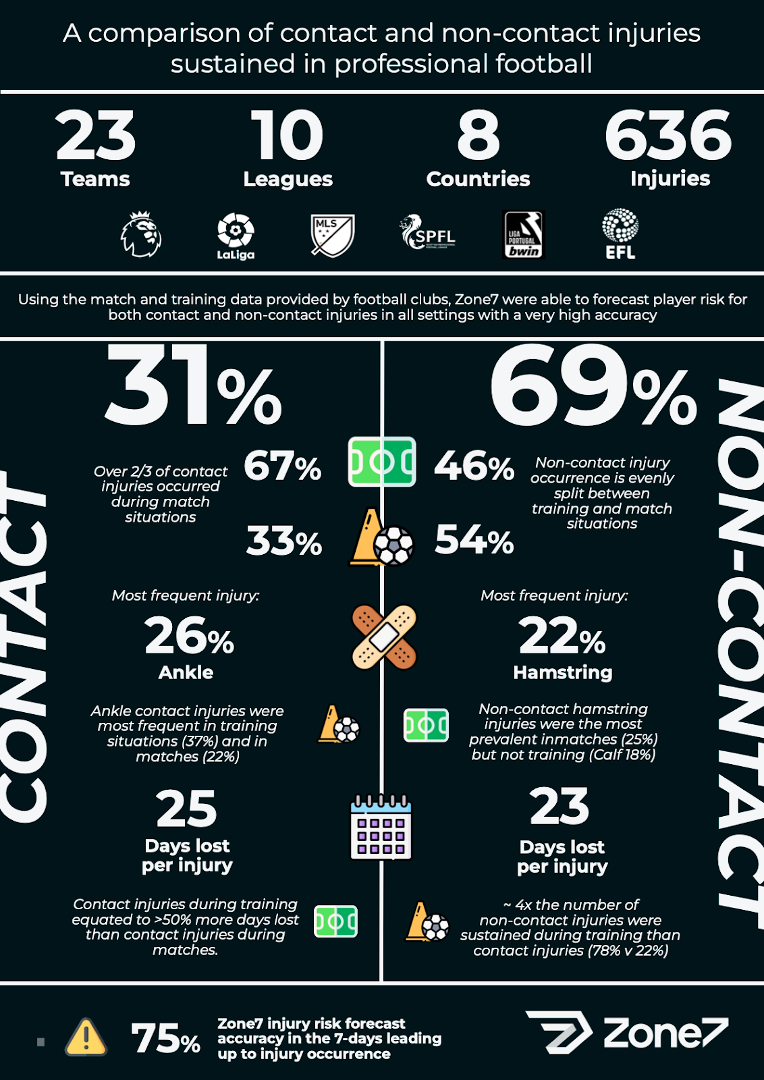Zone7’s newly appointed Data Research Analyst Ben Mackenzie has, again, interrogated an appropriate portion of Zone7’s huge football data-lake. This time he has done so to compare contact and non-contact injuries sustained within professional football.
Often, contact injuries are overlooked when reviewing injury data as they are considered unavoidable. However, this research aims to ask whether that is really the case. There are certainly occasions whereby an opponent’s clumsiness or recklessness can result in injury for an athlete, but what about other instances where an athlete has, for example, made a poor decision during competition or not been able to avoid contact with an opponent?
This research dives into the data to see if there are specific factors that contribute to the identification of these moments within professional football.

Mental fatigue
When looking at specific factors, fatigue is one that should certainly be considered. Fatigue can be categorised in a number of ways and each can have an impact on an athlete’s ability to perform physical activities at a consistently high level;
Mental fatigue during prolonged activity could impair an individual’s ability to make sound decisions and as a consequence could place that athlete in harm’s way as a result of a delayed decision, indecisiveness, or poor quality of decision1.
Neuromuscular fatigue
In addition, central or neuromuscular fatigue can also contribute to an athlete’s risk of injury. Jumps performed by an athlete on a force plate can provide information as to the speed at which motor units are recruited to perform a specific action. A consistent flight time during a countermovement jump can be achieved by the same athlete in both a fresh and fatigued state. However, the time spent during the concentric phase of the take-off can provide an indication of neuromuscular fatigue2 with longer concentric times indicating more fatigue due to the extended time taken to recruit the necessary motor units. This translates into pitch-based activity as athletes will be required to spend longer times recruiting the necessary motor units to perform a given action and will therefore have a greater ground contact time (GCT) than when less fatigued. This increased GCT, however trivial, will delay the athlete’s ability to avoid an opponent during a challenge and therefore increase their risk of sustaining an injury.
NB: The same theory can affect non-contact injuries as greater demand is placed on the muscles in order to complete physical activities to the level required.
Peripheral fatigue
Finally, peripheral fatigue could reduce an athletes’ ability to perform key physical actions. Peripheral fatigue affects the muscles directly and often occurs following a bout of intense exercise reducing the athletes’ ability to reproduce the same bout of exercise to the same level of intensity within a short space of time. The resulting reduction in force production again places the athlete at risk of contact injuries due to their inability to evade contact effectively or in an appropriate manner.
Physiological responses
Physiological responses should also be considered and these are quite often related to previous injuries. For instance, joint effusion – the protective swelling associated with some injuries that is often found amongst athlete’s partaking in contact sports – can inhibit physical apparatus to the point of reducing an athletes’ proprioceptive capabilities. Furthermore, individuals with previous joint injuries have been shown to have significantly impaired proprioceptive capabilities in the same joint, and contra-lateral uninjured joints3.
This investigation into contact and non-contact injuries lead to some interesting findings. The significant highlights include;
- >50% increase in days lost per contact injury sustained in training when compared with contact injuries sustained during matches;
- Non-contact calf injuries are more likely to be sustained during training (68.7%, 99% CI [51.4, 86.0]) than during matches (31.3%, 99% CI [14.0, 48.6]);
- Non-contact quadricep injuries, similarly, are more likely to occur during training than matches, albeit with a small crossover in confidence interval (Training = 63.4%, 95% CI [48.7, 78.1], match = 36.6%, 95% CI [21.9, 51.3]);
- And, Injuries in training are more likely to be non-contact (78.2, 99% CI [71.3, 85.1]) than contact (21.8%, 99% CI [14.9, 28.7].
As soft tissue injuries are more likely to occur during training, and given the data derived from the outcome of this investigation, practitioners should be able to help mitigate this risk as training volume and intensity are controlled by the coaching and support staff. The forecasting models in place at Zone7, coupled with the data provided by football clubs in this investigation, would have provided accurate risk forecasting (75%) to the respective football clubs that may have been beneficial in informing the decisions of the staff when programming, or modifying individual and team training.
References
-
Smith, M. R., Thompson, C., Marcora, S. M., Skorski, S., Meyer, T., & Coutts, A. J. (2018). Mental fatigue and soccer: Current knowledge and future direction. Sports Medicine, 48, 1525-1532. https://doi.org/10.1007/s40279-018-0908-2
-
Pao-Yen Wu, P., Sterkenburg, N., Everett, K., Chapman, D. W., White, N., & Mengersen, K. (2019). Predicting fatigue using countermovement jump force-time signatures: PCA can distinguish neuromuscular versus metabolic fatigue. PLoS ONE, 14(7), Article e0219295. https://doi.org/10.1371/journal.pone.0219295
Al-Dadah, O., Shepstone, L., & Donell, S. T. (2020). Proprioception deficiency in articular cartilage lesions of the knee. Knee Surgery & Related Research, 32, Article 25. https://doi.org/10.1186/s43019-020-00042-7
Ready to Elevate your Performance? We provide a comprehensive suite of products and services utilizing data and AI to enable greater performance and durability amongst high-performance teams.
To find out more about our work, Book a Demo today.


